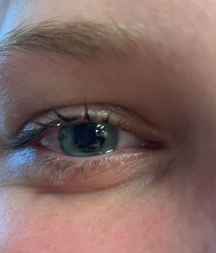Crying for Help
Many different students cry but many don’t know that it is healthy for you.

Junior Kyra Cook demonstrates crying tears of happiness. Some of the benefits of “happy” tears include relieving pain, keeping emotional balance, and improving one’s overall well-being.
April 27, 2022
With each tear that falls on your cheek, oxytocin and endorphins are released in your brain. Some may view crying as a form of weakness and self-defeat, but research proves that shedding tears is one of the healthiest ways to provide relief to mental, emotional, and physical pain.
According to Medical News Today, there are many aspects of crying that can positively affect the well-being of a person. It can provide a soothing effect that helps calm someone down. Crying can also “release toxins and relieve stress” because certain stress hormones are released through tears. There are many physical advantages to crying as well, including fighting bacteria in the eyes, improving vision, and aiding sleep.
Other studies have shown that after someone is done crying, they feel a boost in their mood along with their sense of relief. Harvard Health Publishing said there are different types of tears for various physical or psychological triggers. For example, some tears are caused by pain while some tears are created to remove debris from the eyes.
The Harvard Medical School then explained the social pressure that society has put on males in the world. “From early on, boys are told that real men do not cry. When these boys grow up, they may stuff their feelings deep inside and withdraw emotionally from their loved ones, or self-medicate with alcohol or drugs, or even become suicidal,” the article states. A healthy solution to this problem according to the researchers, is for men to connect with their emotions early in their lives.
In a recent study conducted by the CDC, they found that the number of teens feeling sadness or hopelessness in the United States has risen by 18 percent from 2009 to 2021. The recent COVID-19 pandemic has also caused an uprise in suicidal thoughts among teenagers, with LGBTQ+ individuals experiencing the majority of these depressive symptoms and thoughts. The Atlantic suggests in an article that mental health issues in teens are likely overlooked due to various reasoning. Their research shows that too much social media use and modern parenting styles among other things are the leading causes of why there is an “extreme teenage mental-health crisis.”
A survey went out to all students and staff at Atlantic High school to which 65 people responded. 66.1 percent reported they had cried sometimes in the past week, while 10.8 percent said it had been a month since they last cried. 12.3 percent said they had not cried much in the past year while 10.8 percent said they had not cried in years. Not crying for long periods of time is called anhedonia, and for some people, it isn’t concerning. However, for some, it is a symptom of depression and other mental health disorders. There are many outlets you can reach out to if you are exhibiting anhedonia or other depressive symptoms. One of those means is SAMHSA’s National Helpline with the phone number 1-800-662-HELP (4357) which is open 24/7 year-round.
Nearly 50 percent of respondents said they cried multiple times a week. The leading reasons that caused these people to cry were stress, frustration, and sad music and/or movies. Some other factors that caused sadness to occur in the lives of these individuals were family problems, grieving, and relationship problems. Some students and staff said that crying made them feel better, or relieved, while others said it made them feel ashamed.
Junior Abbigael Richter said she feels weak when she cries. “I don’t feel like a strong person anymore,” she said. Although she doesn’t cry often, stress and not meeting the goals she sets for herself are some of the biggest factors that cause her to feel distraught. She also feels that teen girls are dealing with mental health issues at high rates “because girls don’t think they are ‘pretty’ like the girls they see on Tiktok, Instagram, and VSCO.” Richter feels defeated when she cries, and she thinks it should be more socially acceptable to do so.
Christien Foegen is a sophomore who also believes it should be more socially acceptable to cry, especially for males. “I believe, what makes me feel so ashamed, is [people] saying ‘boys don’t cry,’ and the overall consciousness that ‘men must be tough,’” he said. He thinks it is important to teach people that it is okay to cry. He said, “crying allows one’s self to feel better afterward and it removes bad stuff from the body,” but he also mentioned how crying can make someone feel embarrassed or exhausted. His main reasons for tearing up are family issues, death, and stress.
“Great,” is how freshman Mia Kloewer feels after crying. She said she doesn’t cry often, but when she does it is due to stress, family, and school. “[Crying] lifts a lot of weight off my shoulders,” Kloewer said.
School Counselor Sarah Rose describes herself as an emotional person. She cries “a couple of times a week” due to reasons such as stress and feeling overwhelmed. “I’m a very empathetic person, so if I see somebody that I can tell is going through a lot and they’re telling me something really intense, then I’ll have that emotion,” she said. Rose comforts people by sharing emotions with students to let them know they are heard. She then explained the biological aspects of crying that can make someone feel “released” and relaxed. She said, “there is a lot of science that supports allowing yourself to cry, and how it can send positive endorphins into your brain to make you feel calmer, depending on the type of cry.” Then she explained the negative stigma around crying, especially surrounding men and sometimes women in positions of power. “As a society, our awareness about the health benefits of expressing emotion is starting to be a little more known,” she said. Rose also said that if someone is not releasing their emotions in a healthy way, they can bottle them up. This can sometimes lead to unhealthy ways of releasing emotion such as violent outbursts or substance abuse.
Other healthy forms of dealing with emotions include exercising, journaling, or talking about your feelings with someone you trust, and practicing regular self-care. These activities are proven to release positive endorphins and dopamine into your body that boost your overall mood.









Carol L. parman • May 10, 2022 at 7:41 pm
I l ove this article ….because I have written about alcoholism in my family. Rainbows of Joy from a Diary of Despair by Lynn M. Was published by Outskirts Press 2017.